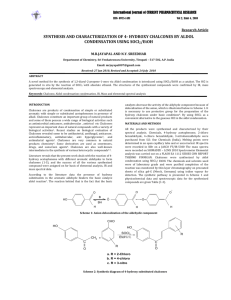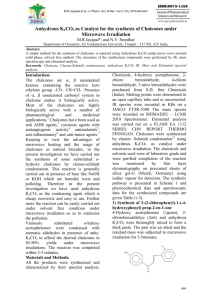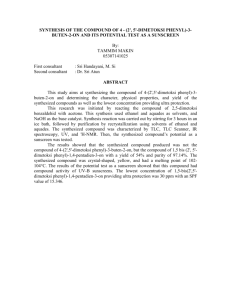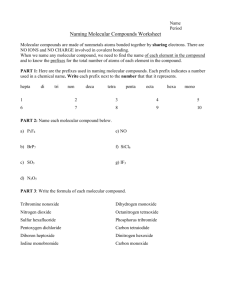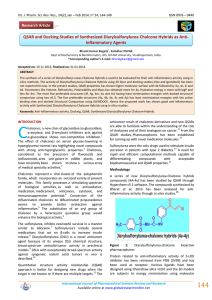Synthesis And Characterization Of 2, 5
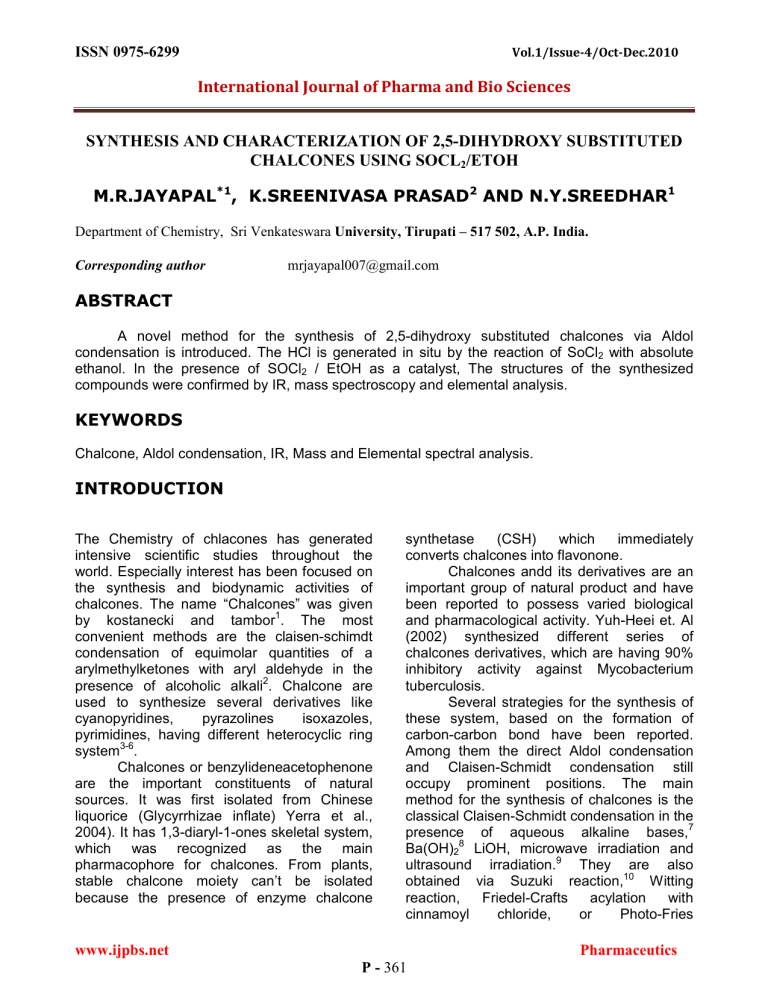
ISSN 0975-6299 Vol.1/Issue-4/Oct-Dec.2010
International Journal of Pharma and Bio Sciences
SYNTHESIS AND CHARACTERIZATION OF 2,5-DIHYDROXY SUBSTITUTED
CHALCONES USING SOCL
2
/ETOH
M.R.JAYAPAL
*1
, K.SREENIVASA PRASAD
2
AND N.Y.SREEDHAR
1
Department of Chemistry, Sri Venkateswara University, Tirupati – 517 502, A.P. India.
Corresponding author mrjayapal007@gmail.com
ABSTRACT
A novel method for the synthesis of 2,5-dihydroxy substituted chalcones via Aldol condensation is introduced. The HCl is generated in situ by the reaction of SoCl
2
with absolute ethanol. In the presence of SOCl
2
/ EtOH as a catalyst, The structures of the synthesized compounds were confirmed by IR, mass spectroscopy and elemental analysis.
KEYWORDS
Chalcone, Aldol condensation, IR, Mass and Elemental spectral analysis.
INTRODUCTION
The Chemistry of chlacones has generated intensive scientific studies throughout the world. Especially interest has been focused on the synthesis and biodynamic activities of chalcones. The name “Chalcones” was given by kostanecki and tambor
1
. The most convenient methods are the claisen-schimdt condensation of equimolar quantities of a arylmethylketones with aryl aldehyde in the presence of alcoholic alkali
2
. Chalcone are used to synthesize several derivatives like cyanopyridines, pyrazolines isoxazoles, pyrimidines, having different heterocyclic ring system
3-6
.
Chalcones or benzylideneacetophenone are the important constituents of natural sources. It was first isolated from Chinese liquorice (Glycyrrhizae inflate) Yerra et al.,
2004). It has 1,3-diaryl-1-ones skeletal system, which was recognized as the main pharmacophore for chalcones. From plants, stable chalcone moiety can’t be isolated because the presence of enzyme chalcone synthetase (CSH) which immediately converts chalcones into flavonone.
Chalcones andd its derivatives are an important group of natural product and have been reported to possess varied biological and pharmacological activity. Yuh-Heei et. Al
(2002) synthesized different series of chalcones derivatives, which are having 90% inhibitory activity against Mycobacterium tuberculosis.
Several strategies for the synthesis of these system, based on the formation of carbon-carbon bond have been reported.
Among them the direct Aldol condensation and Claisen-Schmidt condensation still occupy prominent positions. The main method for the synthesis of chalcones is the classical Claisen-Schmidt condensation in the presence of aqueous alkaline bases,
7
Ba(OH)
2
8
LiOH, microwave irradiation and ultrasound irradiation.
9
They obtained via Suzuki reaction, are
10 also
Witting reaction, Friedel-Crafts acylation with cinnamoyl chloride, or Photo-Fries www.ijpbs.net Pharmaceutics
P - 361
ISSN 0975-6299 rearrangement of phenyl cinnamates. In aldol condensation the preparation of chalcones requires at least two-steps aldol formation and dehydration. Since aldol addition is reversible, mukaiyama or Claisen-Schmidt condensation approach of using enol ether has emerged as an alternative pathway.
The aldol reaction is also performed under acidic medium,
11
using HCl, BF
3
, B
2
O
3, p-toluenesulfonic acid etc. Recently various modified methods for the synthesis of chalcones has been reported, such as by using
SOCl
Na
2
2
,
12
natural phosphate, lithium nitrate,
13 amino grafted zeolites,
14
CO
3
,
16
, PEG
400,
17
zinc oxide, water,
silicasulfuric acid,
15
18-19
ZrCl
4
and ionic liquid
20
etc. Jhala et al. synthesized chalcone using basic alumina under micro wave irradiation. However, many of these methods suffered from harsh reaction condition, toxic reagents, strong acidic or basic conditions, prolonged reaction-times, poor yields and low selectivity. Although, several modifications have been made to counter these problems. There is still a need for the development of selective and better strategies for the synthesis of α , β -unsaturated carbonyl compounds.
However, many of these methods suffered from harsh reaction condition, toxic reagents, strong acidic or basic conditions, prolonged reaction times, poor yields and low selectivity. Although, several modifications had been made to counter these problems. There is still a need for the development of selective and better strategies for the synthesis of α , β unsaturated carbonyl compounds.
According to the literature data the presence of hydroxy substituents in the aromatic aldehyde hinders the basis catalyze aldol reaction. The reason behind that is the
Vol.1/Issue-4/Oct-Dec.2010 fact that the basis catalysts decrease the activity of the aldyhyde component because of delocalization of the anion, which is illustrated below in Scheme 1. It is necessary to use protective group for the preparation of the hydroxy chalcones under basis conditions
21
. By using SOCl
2
as a convenient alternative to the gaseous HCl in the aldol condensation.
MATERIALS AND METHODS
All the products were synthesized and characterized by their spectral analysis.
Chemicals, 2,5-hydroxy acetophenone, 2chlorobenzaldehydes, 4-chloro benzaldehydes, 3-nitrobenzaldehydes were purchased from S.D. fine Chemicals (India).
Melting points were determined in an open capillary tube and or uncorrected. IR spectra were recorded in KBr on a JASCO FT/IR-
5300 The mass spectra were recorded on
LCMS – 2010 A DATA REPORT SHIMADZU
Elemental analysis was carried out on a
Flash EA 1112 SERIES CHN REPORT
THERMO FINNIGAN. Chalcones were synthesized by aldol condensation
23
using
SOCl
2
/ EtOH. The chemicals and solvents used were of laboratory grade and were purified completion of the reaction was monitored by thin layer chromatography on precoated sheets of silica gel-G (Merck,
Germany) using iodine vapour for detection.
The synthetic pathway is presented in
Scheme 2 and physicochemical data and spectral data for the synthesized compounds are given Table(1-3).
O O O
HO
B
O O
BH
H H
Scheme 1
Anion delocalization of the aldehydic component
H www.ijpbs.net Pharmaceutics
P - 362
ISSN 0975-6299
CHO
Vol.1/Issue-4/Oct-Dec.2010
HO
OH
C
CH
3
SOCl
2
EtOH
HO
OH
C
R
O
R
O a. R= 2-Cl b. R= 4-Cl c. R= 3-NO
2
Scheme 2
Synthetic diagram of 2,5 dihydroxy substituted chalcones
1) Synthesis of 3-(2-chlorophenyl) -1- (2,5-dihydroxyphenyl) prop-2-en-1-one
To a stirred mixed of 2,5-hydroxy acetophenone (0.01 mol) and 2-chloro benzaldehyde (0.01 mol) in absolute ethanol (5 ml) and thionyl chloride (0.05ml) dropwise and continue stirring for two hour at room temperature. Allow to stand reaction mixture for 12 Hr. Precipitate the reaction mixture by addition of water. Filter the product, wash with cold ethanol and allowed to afford.
Cl
OH
OH
C
O
2) Synthesis of 3-(4-chlorophenyl) -1-(2,5-dihydroxyphenyl) prop -2-en-1-one
Reaction with 2,5-dihydroxy acetophenone (1.2 gms) and (4-chlorobenzal dehyde (1.1 gms), 3-(4-chlorophenyl) -1 (2,5- dihydroxyphenyl) prop -2-en-1-one obtained by the above procedure.
OH
Cl
OH
C
O
3) Synthesis of 1-(2,5-dihydroxyphenyl)-3-(3-nitrophenyl)prop-2-en-1-one
1-(2,5-dihydroxyphenyl)-3-(3-nitrophenyl) prop-2-en-1-one was obtained by the above procedure expect that the starting material used was 2,5-dihydroxy acetophenone (2 gms) in ethanol add thionylchloride (0.05) and
3-nitrobenzaldehyde (1.3 gm)
NO
2
OH
OH
C
O www.ijpbs.net Pharmaceutics
P - 363
ISSN 0975-6299 Vol.1/Issue-4/Oct-Dec.2010
RESULTS AND DISCUSSIONS
The yields of the synthesized
This paper reports a simple and effective method for the synthesis of chalcones by an acid catalyzed aldol reaction we used SOCl
2
as a convenient alternative to the gaseous HCl in the aldol condensation.
The HCl is generated in situ by the reaction of
SOCl
2
with absolute ethanol. Chalcones are obtained in good to good to excellent yields.
Our purpose was to synthesize a series of chalcones, starting from benzaldehyde and compounds were found to be significant. The structure of the synthesized compounds was confirmed by IR, Mass and elemental analysis. Elemental analysis showed that the percentage of the nitrogen, hydrogen and carbon was found experimentally is equivalent to the calculated values in all compounds. All the compounds give the characteristic IR peak that proved that the presence of particular functional group (Table
2) and mass spectroscopy helps to find the acetophenone or their substituted derivatives using SOCl
2
/ EtOH as a catalyst. Synthesis of chalcone is a single step method. The synthesized chalcone derivatives were molecular weight of the synthesized compounds (Table 2). The Chalcone derivatives showed that the molecular ion peak that equivalent to the molecular weight undergone physicochemical characterization and spectro chemical data the obtained of proposed compound. Hence m/z value confirms the molecular weight of the results are given in Table.1-3. respective synthesized compound.
Table1
Physicochemical characterization data for synthesized compounds
Compound number
Molecular formula
Molecular
Weight
Yield
(%)
MP
(°C)
Elemental analysis
C H N
1
2
3
C
15
H
11
ClO
3
274 85 180 65.48
(65.75)
C
15
H
11
ClO
3
274 89 182 65.71
(65.75)
C
15
H
11
NO
5
285 81 190 63.18
(63.21)
Teble.2
IR spectral data of synthesized compounds
3.96
(4.04)
4.10
(4.04)
3.89
(3.89)
-
-
4.98
(4.91)
Compound number
1
Compound
2
3
3-(2-chloro phenyl) -1- (2,5-dihydroxy phenyl) prop-2-en-1-one
3-(4-chloro phenyl) -1-(2,5- dihydroxyphenyl) prop -2-en-1-one
1-(2,5-dihydroxyphenyl)-3- (3 nitro phenyl) prop-2-en-1-one
IR. Spectral data
IR (KBr) v cm
-1
(C=0) 1591 cm
, (-OH) 3310 cm
-1
-1
,
, (C=C) 1481 cm
-1
IR (KBr) v cm
-1
(C=0) 1682 cm
, (-OH) 2982 cm
-1
-1
,
, (C=C) 1626 cm
-1
IR (KBr) v cm
-1
(C=0) 1692 cm
, (-OH) 2986cm
-1
-1
,
, (C=C)1632 cm
-1
Table.3
Mass spectral data of synthesized compounds
Compound number
1
Compound Molecular weight
274
Mass spectral data
274 M
+2
2
3
3-(2-chloro phenyl) -1(2,5-dihydroxy phenyl) prop-2-en-
1-one
3-(4-chloro phenyl) -1 (2,5- dihydroxy phenyl) prop -2en-1-one
1-(2,5-dihydroxyphenyl) -3 – (3 nitro phenyl) prop-2-en-
1-one
274
285
274 M
+2
285 M
+ www.ijpbs.net Pharmaceutics
P - 364
ISSN 0975-6299
→ 3-(2-chlorophenyl)-1-(2,5dihydroxyphenyl)prop-2-en-1-one have molecular formula C
15 ion peak at 274 (M
H
+2
11
ClO
3
.
The molecular
) showed that m/z is equivalent to molecular weight of proposed compound. Hence m/z value confirms the molecular weight of the compound. The IR band at 1591cm
-1 suggesting the presence of
(C=O) group. The IR band at 1481cm
-1 indicates that the presence of (C=C) group. IR band at 3310 cm
-1
indicates presence of (-OH) group. Melting point of the compound is 180 °C which is uncorrected.
→ The molecular formula of 3-(4-chloro phenyl) -
1(2,5- dihydroxyphenyl) prop -2-en-1-one is
C
15
H
11
ClO at 274 (M
3.
+2
The obtained molecular ion peak
) showed that m/z is equivalent to molecular weight of proposed compound.
Hence m/z value confirms the molecular weight of the compound. The IR band at 1682 cm
-1 suggesting the presence of (C=O) group. The
IR band at 1626 cm
-1
indicates that the presence of (C=C) group. IR band at 2982 cm
-1 indicates presence of (-OH) group. Melting point of the compound is 182°C which is uncorrected.
→ The obtained ion peak of 1-(2, 5hydroxyphenyl)-3-(3 nitrophenyl) prop-2-en-1one (molecular formula, C
15
H
11
NO
5
) at 285
(M
+
) showed that m/z is equivalent to molecular weight of proposed compound.
Hence m/z value confirms the molecular weight
REFERENCES
1. Kostanecki, S.V. and Tambor, J.: chem.
Ber., 32:1921 (1899).
2. Kazauki, K Hitayama,K.; Yokomor,S. and
Soki, T.; Chem Abstr., 85:5913 (1976).
3. El.Hashah, M.A.; El-Kady.M.; Saiyed,
M.A.and Elaswy, A.A.; Egypt.J.Chem.,
27: 715 (1985).
4. Crawley, L.S.and Fanshawe, W.J.,
J.Heterocyclic chem.., 14:531 (1977)
Vol.1/Issue-4/Oct-Dec.2010 of compound. The IR band at 1692 cm
-1 suggesting the presence of (C=O) group.
The IR band at 1632 cm
-1
indicates that the presence of (C=C) group. IR band at
2986 cm
-1
indicates presence of (-OH) group. Melting point of the compound is
190°C which is uncorrected.
CONCLUSIONS
In conclusion we found that 2,5 dihydroxy chalcones can be synthesized using the catalytic system SOCl
2
/ EtOH.
The synthesized compounds were characterized by TLC, melting point, IR spectroscopy, elemental analysis and mass spectroscopy. The results obtained form this study confirmed that the product has formed.
Henceforth viewing these characteristic properties more compounds can be synthesized and subjected to pharmacological evaluation.
ACKNOWLEDGEMENTS
One of the authors are grateful to the
Head of the Department, Chemistry, Tirupati for providing the necessary facilities for undertaking this research work.
5. Taylor, E.C. and Morrison, R.W.,
J.Org.Chem., 32:2379 (1967).
6. Utale, P.S.; Rathuvanshi, P.B.and Doshi,
A.G.; Asian J.Chem., 10:597 (1998).
7. Rajendra Prasad Y., lakshmana Rao A.,
Rambabu R. And Ravi Kumar P.
Oriental J. Chem. 23(3): 927-937 (2007), www.ijpbs.net Pharmaceutics
P - 365
ISSN 0975-6299
8. Srinivasa Rao M., Kotesh J., Narukulla
R. And Duddeck H., Arkivoc, xiv, 96-102:
(2004)
9. Calvino V., Picallo M., Lopez-peinado A.
J., Martin-Aranda R.M. and Duran-Valle
C.J. Applied Surface Science, 252 (17):
6074(2006)
10. Eddarir S., Catelle N., bakkour Y. and
Ronlando C. Tetrahedran Lett. 44 (28):
5359-5363(2003)
11. Koniezny M.T., Konieczny W., Sabisz M.,
Skladanowski A., Wakiec R.,
Augustnowicz Kopec E. And Zwolska Z.,
European J.Medicinal Chem., 42(5):729-
733(2007)
12. Petrov O.Ivanova, Y.and Gerova M.,
9(2): 315-316 (2008)
13. Sebti S., Solhy A., Smahi A., Kossir A.
And Oumimoun H., Catalysis Commun.
3:335-339(2002)
Vol.1/Issue-4/Oct-Dec.2010
14. R.P.Pawar et al, Int.J.Chem Tech
Res.1(2): (2009)
15. Jhala Y.S., Dulawat S.S.and Verma B.L.,
Indian.J. chem.. 45B: 466-469. (2006)
16. Perozo-Rondon E., Martin-Aranda R.M.,
Casal B., Duran-Valle C.J., Lau W.N.,
Zhang, X.F.adn Yeung K.L., Catalysis
Today, 114(2-3): 183-187(2006)
17. Craig M., Comisar P.And Savage Green
Chem. 6: 227-231(2004)
18. Zhang Z., Dang Y.W., Guan-Wu.and
Wang G.W., Chemistry Letters, 32:
10(2003)
19. Tanemura K., Suzuki T., Nishida Y. And
Horatguchi T., Chemistry Letters, 34:4.
(2005)
20. Thirunarayanam G.and Vanangamudi
G., Arkivoc, 7: 58-64 (2006)
21. Zhang Z., Dang Y.W., Guan-Wu.and
Wang G.W., Chemistry Letters, 32:
10(2003) www.ijpbs.net Pharmaceutics
P - 366
